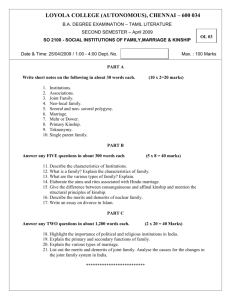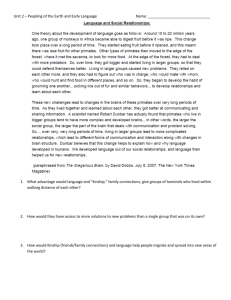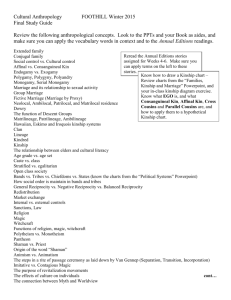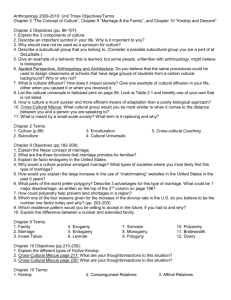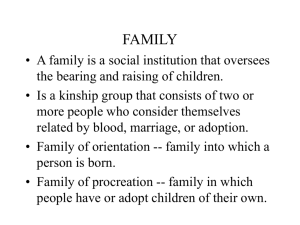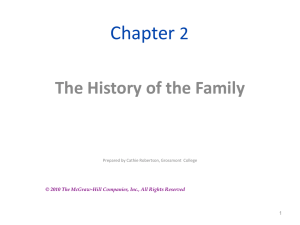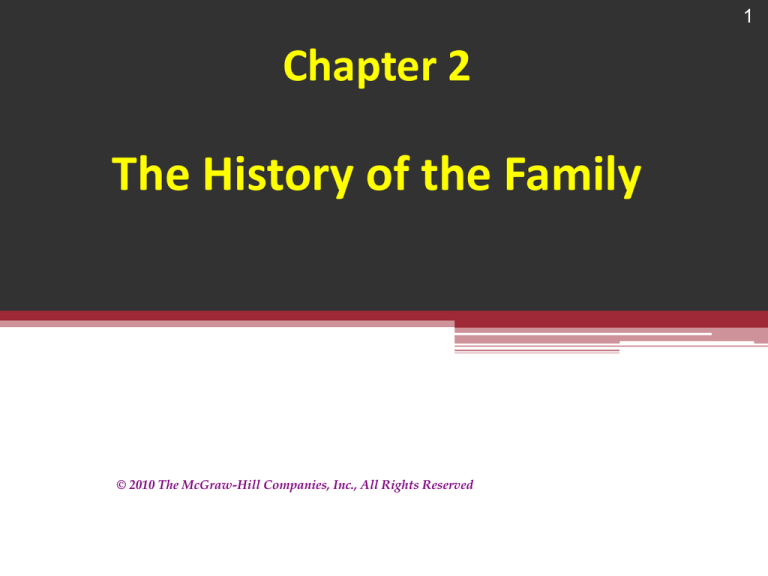
1
Chapter 2
Chapter
The2History of the Family
© 2010 The McGraw-Hill Companies, Inc., All Rights Reserved
2
Sun Myung Moon’s Mass Weddings
• http://www.thedailybeast.com/galleries/2012/09/02
/mass-weddings-by-sun-myung-moonphotos.html#slide1
3
History of the Family
• Historians--Upper class bias
▫ Nobles
▫ Wars
▫ Rise & fall of empires
• First, study of “ordinary” families
▫ 1960
4
9/3 Philippe Aries
CENTURIES OF CHILDHOOD (1963)
• Concept of “Childhood”
• Innocent
• Protect
• Hidden from children:
•
•
•
•
•
Birth
Death
Sex
Tragedy
World events
5
Philippe Aries--CENTURIES OF CHILDHOOD
• Children segregated by age
• Having an age important
• In the past ages were unknown
6
17th Century
7
18th Century
8
19th Century
9
19th Century
10
20th Century
11
Origins of Family and Kinship
Evolutionary theory
Infants need care Families
Hunter-gatherers: For 3 million years
Until invention of agriculture
(8000-10,000 years ago)
12
Hunter-gatherers
• Small bands (approx. 30 people)
▫ Several families
▫ Nomads
• Group size=Depended on food in region
• Men
▫ Hunted, fished
• Women
▫ Gathered nuts, berries
▫ Cared for children
• Children also worked
13
Agriculture
Settled agriculture
10,000 years ago
People discover how to cultivate
crops and domesticate animals
14
Kinship
Kinship traced through mother’s or father’s
kin
Lineages
Patrilineage: Father’s line
Matrilineage: Mother’s line
15
Origins of Family and Kinship
Kinship Groups
Ensure order
Defend against outsiders
Provide labor
Assist others in group
Recruit new members
Through marriage
16
9/5 Origins of Family and Kinship
• In most societies--smaller family units
▫ Mother and children (always)
▫ Husband/father (usually)
▫ Other household members
(sometimes)
17
Origins of Family and Kinship
Western culture—Smaller kinship groups
Conjugal family:
Husband,
Wife and
Children
Extended family: Other relatives in
household
18
Origins of Family and Kinship
• Family and kinship systems:
• Fundamental needs:
▫ Reproduction
▫ Food
▫ Defense
▫ Safety
19
The American Family before 1776
• American Indian Families
• European Colonists
• African Slaves
20
American Indian Families:
The Primacy of the Tribes
• Indigenous people in the 48 territories that
became United States
• Family units based on lineages
Tribes, both matrilineal and patrilineal
Matrilineal ties to maternal kin
Patrilineal ties to paternal kin
21
American Indians
22
European Colonists:
The Primacy of the Public Family
• Families performed public services:
▫ Education
▫ Hospitals
▫ Houses of correction
▫ Orphanages
▫ Nursing homes
▫ Poor houses
23
European Colonists
24
European Colonists:
The Primacy of the Public Family
• No room for privacy or private lives
▫ Family affairs=public business
▫ Houses not designed for privacy—public
▫ Little privacy from other households
▫ Conjugal family is integral part of society
25
European Colonists:
The Primacy of Public Family
• Family Diversity
• Not all families “ideal conjugal” family
▫ Stepfamilies due to death of parents
▫ Marriage not always official
More common in Middle Colonies
Bigamy
Men migrated West and began new family
Emergence of the “Modern” American
Family: 1776 to 1900
Four characteristics:
1. Marriage— mutual respect and affection
2. Wife (morally superior) cared for home & children
3. “Childhood” protect and support children
4. Decline in number of children per family
27
The Emergence of the “Modern” American
Family: 1776 to 1900
• Individualism
• Personal relationships within families
• Enhanced emotional rewards
• Support autonomy
28
From Cooperation to Separation:
Men’s and Women’s Spheres
Change in mode of production
▫ Capitalism
▫ From “family labor” to “paid labor”
• Men worked outside the home
▫ Business ethic
▫ Focus—world outside home
29
From Family Labor to Paid Labor
30
Men: Paid Labor Outside Home
• http://www.history.com/videos/the-industrialrevolition#the-industrial-revolition
31
From Cooperation to Separation:
Men’s and Women’s Spheres
• Women worked inside the home
▫ Renew husbands’ character & spirituality
• “Cult of True Womanhood "women were:
Upholders of spiritual values
Pure
Submissive to men
Domestic
32
Cult of True Womanhood
• http://www.youtube.com/watch?v=wtXNNAs9u0M&fe
ature=player_embedded#!
33
Happy Homemakers
34
19th Century Families
Harriet Tubman and Family
35
African Families in America
• Africans: Traded as slaves for
centuries
▫ Captured or bought in West Africa
▫ Sold as slaves
36
African Families in America
African society
• Organized by lineages
Marriage is a process
37
Zulu Courtship and Weddings
Girls of courting age send beaded
“love letters” to young man
He comes courting
Girl presents young man with string of
white beads
38
The Process
• Process begins with lobola
agreement
• Shows groom’s commitment to his
bride
• “Compensation” to father & his kraal
(rural village) for loss of girl
• Bridegroom & family claim children
39
The Process
• Lobola paid in head of cattle
- Amount agreed upon by the families
• Cattle delivered in ‘installments’ to the
bride’s father
• Continue for a year or two
▫ Until bridegroom’s family insists on a
wedding
40
The Process
Weddings—Joyous singing, dancing and
mock fighting by warriors in traditional
dress
Community joins in the celebrations
Women wear:
• Traditional headdresses
• Beautiful beaded necklaces
• Soft leather aprons
41
The Process
• Must be night with a bright moon
▫ Faint moon signifies bad luck
▫ Makes the celebrations less festive
• Held outside in bridegroom’s village
• Parents of the bride do not attend
▫ Would be too sad for them
42
Influence of Slavery on Family
• Family life difficult
• Slavery stripped elders of authority over
marriage process
• Enslaved often married for life
▫ Kept track of extended family
• Most families—two parents
43
Before 1865
• Enslaved people could not legally marry
• Colonial & state laws considered them
property
▫ Not legal persons who could enter into
contracts
• Marriage is a legal contract.
44
After 1865
• Free African Americans could marry
• In northern states:
• New York
• Pennsylvania
• Massachusetts
• In slave states of the South:
• Formed relationships that they treated like
marriage
▫ Considered themselves husbands and wives
45
After the Civil War
• Essential to freedom:
▫ Reuniting families separated under
slavery
▫ Solidifying existing family relations
• Family is the foundation of the
postwar black community
46
Mexican Families in America
• Mexicans living in area that became part
of U.S.
• Landowners & Farmer-Laborers
• Farmer-laborers—Mestizo—part Spanish
and part Native American
• Compadres: In Mexico, the godparent
relationship with wealthy or influential
person
47
Mexicans in America
•April 23 1846, U.S. Congress declared
war on Mexico
•Treaty of Guadalupe Hidalgo
•Signed on Feb. 2, 1848
• Ended the U.S.-Mexican War
48
Treaty of Guadalupe Hidalgo
U.S. took land area of:
•
•
•
•
•
•
•
Texas
New Mexico
California
Arizona
Nevada
Utah
Half of Colorado
49
Mexico & U.S. After Treaty
50
Mexican-American Families
• Five centuries of Spanish colonization
• Family character combines:
• Feelings of indigenous people
•Traditional feminine subculture
• And Spanish expectations and norms
• Masculine machista orientation
51
Mexican-American Families
• Extended families important
• Families provide support:
• Emotional
• Instrumental
• Guidance
52
Asian Immigrant Families
• Asian Americans in U.S. are of many
ethnicities including:
• Japanese
• Chinese
• Korean
• Filipino
• Asian (East) Indians
• Southeast Asians
53
Asian Immigrant Families
• The Asian Heritage
• Fathers—Authority over family
• Kinship—Patrilineal
• Children expected to care for elderly
• Live with them
• Emphasize family loyalty
54
The Rise of the Private Family: 1900Present
The Early Decades
• Increase in premarital sex
• Decline in births
• Rising divorce rate
• Increase in marriage rate
• Focus on emotional satisfaction
55
The Rise of the Private Family:
1900-Present
• Families less dominant in people’s lives
• Marriage less necessary economically
& materially
• Marriage more fragile
56
The Rise of the Private Family:
1900-Present
• Privacy & private families increased
• Birthrate declined
• Life expectancy increased
• Family housing needs change
57
The Rise of the Private Family:
1900-Present
• Basis of marriage—From economics to
emotional satisfaction and companionship
• Men and women—more economically
independent or interdependent
• Marriage bonds weakened
• Divorce more common
58
Cohorts: The Depression Generation
• Affected family finances
• Undermined authority of father
• Divorce rate fell
• Postponed marriage & childbearing
▫ 1 in 5 never had children (1 in 10
norm)
• Children helped by working
59
The 1950s
• Baby boom (1946-1964)renewed focus on
marriage and children
▫ More children than before
▫ Preferred family size increased
• Highpoint of breadwinner-homemaker
model
▫ Not really the “traditional family”
▫ Faded quickly
60
1950s Family
61
1960s and Beyond
• Birthrate plunged
• Married average 4-5 years later
• Wanted independence
• Divorce rate doubled 1960s–70s
▫ Declined slightly since
• Cohabitation—1970s
• Women working outside home
62
1960s Family
63
Social Changes in the 20th Century
• The chart (next slide) shows
changes in family and personal life
• Twentieth century
▫ Great change in family
▫ How individuals lead their lives
64
A life-course perspective on social change in the
20th century
65
Emergence of Early Adulthood
• Early adulthood – Period between
mid-teens & about 30
▫ May return to parents’ home
• Labor force =
▫ All people who are working for pay or
▫ Looking for paid work
66
The Role of Education
• Factor in lengthening early adulthood
• More employment opportunities for
college-educated
• Young adults may still marry
▫ May postpone children to further
education
67
Declining Parental Control
• A century ago, young people lived
with parents until marriage
• Today they live apart
• Parents have less control over
children
68
Early Adulthood and
the Life Course Perspective
Study of changes to individuals’ lives
Relationship to historic events
Key transitions:
Infancy
School age
Adolescence
Teenager
Young adult
Adulthood
69
Life Course Perspective
Historical changes such as:
Decline of manufacturing jobs
Employment for well-educated
Greater acceptance of cohabitation
Acceptance of childbearing outside
of marriage
70
Summary: What History Tells Us
Americans come from many regions of the world
Different family traditions
Mix of European, African, Asian, South
American and others
European American family systems
Conjugal unit (mother, father, children)
Division of labor (gender based)
Emphasized individual satisfaction
71
What History Tells Us
• African, Asian, South American Family
• Emphasis on extended kin
Sometimes lineages
Larger family structures
▫ Marriage still central to society


